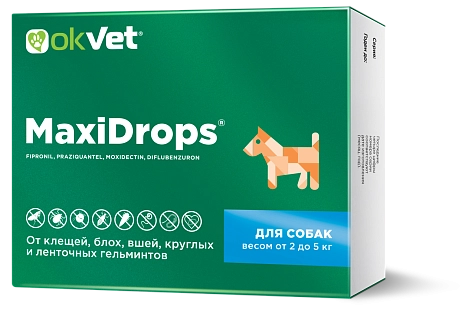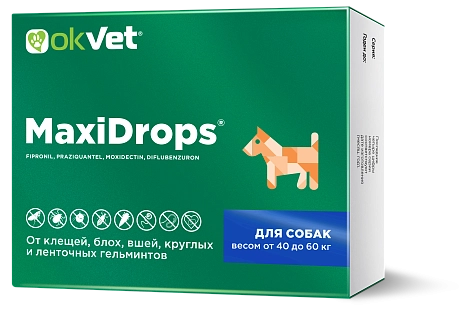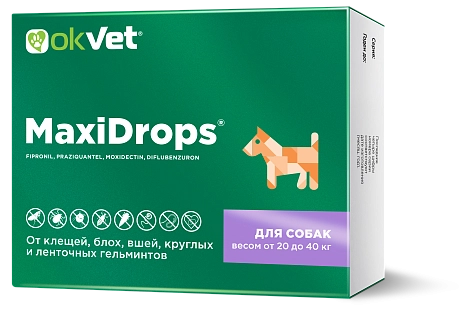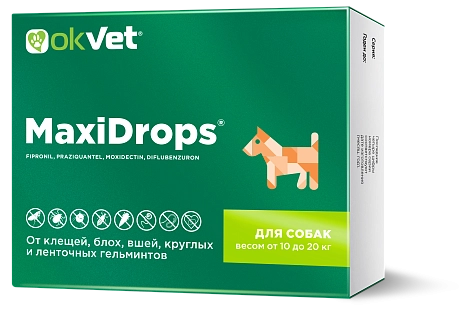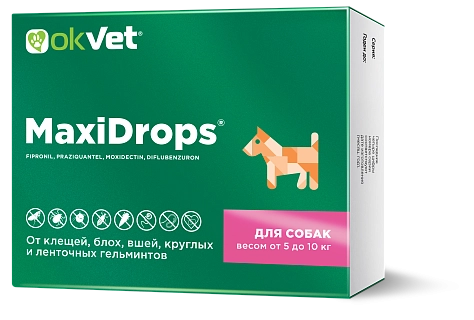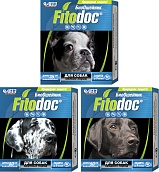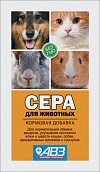Advantages:
- Convenient use - drops on the withers
- It is effective against 37 types of external and internal parasites, including dirofilariae.
- The pet is protected from fleas and ticks for up to 42 days
- Enhanced effect – 4 active ingredients in the composition
- It works before the bite - the parasites die upon contact with the animal's fur and skin.
- Natural oils in the composition improve the condition of the animal's skin, mask the unpleasant smell of the pet.
Composition and properties.
The medicinal product Maxidrops® in two modifications, containing as active ingredients in 1 ml:- "For dogs" - fipronil – 100 mg, praziquantel – 85 mg, moxidectin – 25 mg, diflubenzuron – 1 mg;
- "For cats" - fipronil – 80 mg, praziquantel – 68 mg, moxidectin – 8 mg and diflubenzuron – 1 mg.
As auxiliary substances, the drug contains butylhydroxyanisole, methylpyrrolidone, lavender essential oil, neem oil and diethylene glycol monoethyl ether.
The active substances included in the preparation provide a wide range of its antiparasitic effects against: fleas (Ctenocephalides canis, Ctenocephalides felis), ixodes ticks (Ixodes ricinus, Ixodes persulcatus, Ixodes scapularis, Rhipicephalus sanguineus, Dermacentor reticulatus, Dermacentor silvarum, Dermacentor marginatus, Dermacentor variabilis, Amblyomma americanum, Haemaphysalis flava, Haemaphysalis campanulata), lice (Linognathus setosus, Trichodectes canis, Felicola subrostratus), scabies mites (Sarcoptes canis, Notoedres cati, Otodectos cynotis), thrombidiform mites (Demodex canis, Cheyletiella yasguri), roundworm – nematodes (Ancylostoma caninum, Toxocara canis, T. cati (T. mystax), Toxascaris leonina, Trichuris vulpis, Uncinaria stenocephala, Thelazia callipaeda, Angiostrongylus vasorum, Aelurostrongylus abstrusus, Crenosoma vulpis, Dirofilaria immitis (microfilariae), Dirofilaria repens (microfilariae)) and ribbon helminths – cestodes (Dipylidium caninum, Multiceps multiceps, Taenia hydatigena, Taenia ovis, Taenia pisiformis, Taenia taeniaeformis, Echinococcus granulosus, Alveococcus multilocularis), parasitizing dogs and cats.
Fipronil is a contact insecticide of the phenylpyrazole group. Its mechanism of action consists in affecting chloride channels, in particular GABA-dependent channels, as well as sensitivity-reducing (D) and non-sensitivity-reducing (N) glutamate-dependent channels (glutamate is specific to ligand-dependent chloride channels in invertebrates), thereby blocking the pre- and postsynaptic transfer of chlorine ions through the membrane. As a result, this leads to uncontrolled activity of the central nervous system and the death of ectoparasites upon first contact with the fur and skin of the treated animal (before the bite).
Moxidectin is a macrocyclic lactone active against insects, mites, larvae and imago nematodes of the gastrointestinal tract and larval phases of dirofilariae development. The main targets of moxidectin are glutamate-sensitive chlorine channels, as well as gamma-aminobutyric acid receptors. A change in the current of chlorine ions disrupts the conduction of nerve impulses, which leads to paralysis and death of the parasite. Exerting an additional potentiating effect on gamma-aminobutyric acid (GABA), it accelerates its release from presynaptic terminals and facilitates absorption by postsynaptic receptors of the peripheral nervous system. The attachment of GABA to the receptors of glutamate-sensitive chlorine channels stimulates the influx of chlorine ions, which leads to the development of parasite paralysis.
When applied subcutaneously, moxidectin is well absorbed and enters the systemic bloodstream, organs and tissues. It is mainly excreted unchanged from the body with feces.
Praziquantel is an acylated derivative of pyrazinoisoquinoline. By increasing the permeability of the parasite's cell membranes to calcium ions (Ca2+), it causes de-polarization of the membranes, muscle contraction and destruction of the tegument, which leads to the death of the parasite and promotes its excretion from the animal's body. The maximum concentration of praziquantel in the blood plasma of dogs is reached after 17 hours, in cats - after 5 hours. The compound undergoes rapid and almost complete biotransformation in the liver. The plasma binding level is about 80%, it is excreted from the body within 2 days mainly in the urine.
Diflubenzuron, by inhibiting chitin synthesis in insects and mites, disrupts the process of molting, oviposition, and hatching of larvae from eggs, which leads to the cessation of population replenishment.
After skin application of the drug, fipronil and diflubenzuron are evenly distributed over the surface of the body, practically not absorbed into the systemic bloodstream, accumulate in the epidermis, hair follicles and sebaceous glands of the animal's body and have a long-term contact insecticidal effect. Moxidectin and praziquantel are well absorbed through the skin and penetrates into the systemic bloodstream, distributed in organs and tissues, where they have a systemic antiparasitic effect.
A single treatment of the animal ensures the death of ectoparasites within 24 to 48 hours. The duration of the protective effect of the drug is up to 4-6 weeks against ixodes ticks and up to 5-6 weeks against fleas, lice and cheiletiella.
The excipients included in the preparation - lavender essential oil and neem oil, eliminate the unpleasant smell of wool, improve skin condition, prevent itching and irritation.
Keeping.
The medicinal product is stored in the manufacturer's sealed packaging, in a place protected from direct sunlight at a temperature from 2 ° C to 25 ° C. The drug should be stored in places inaccessible to children.
The shelf life of the medicinal product, subject to storage conditions in the manufacturer's closed packaging, is 2 years from the date of manufacture. It is forbidden to use the drug after the expiration date.
The release form.
Polymer tubes of 2, 4 and 6 ml, instructions for use, sticker in the veterinary passport.
Outer packaging: carton pack.
Indications for use.
Maxidrops® is prescribed to adult dogs and puppies for the treatment and prevention of associative parasitic diseases caused by fleas, ixodes mites, lice, scabies and thrombidiform mites, nematodes and cestodes, for the prevention of dirofilariasis caused by the larvae of Dirofilaria immitis and Dirofilaria repens, as well as to reduce the risk of infection with babesiosis and borreliosis, which are carried by Ixodes the ticks.Contraindications.
Contraindications to the use of Maxidrops® are increased individual sensitivity of the animal to the components of the drug (including in the anamnesis), exhaustion, epilepsy, infectious diseases, hyperthermia, impaired liver and kidney function. Do not use the drug to animals of other species, as well as dogs weighing less than 2 kg and cats weighing less than 1 kg. The drug should not be used in dogs of breeds sensitive to macrocyclic lactones, including the Australian Shepherd (Aussie), White Shepherd, Bobtail (Old English Shepherd), Border Collie, shorthair Collie, longhair collie, McNab, longhair whippet, silky Windhound, Sheltie and their mestizos. The drug should not be used in cats and dogs with genetically determined hypersensitivity (MDR1 deficiency).It is prohibited to use the drug to cats and bitches during pregnancy and breastfeeding, puppies weighing less than 2 kg and kittens weighing less than 1 kg and / or animals younger than 7 weeks of age.
The medicinal product is not intended for use by productive animals.
Doses and the order of application.
Maxiidrops® is applied to animals individually, once, by spot drip application to dry, undamaged skin.After spreading the fur, place the tip of the tube directly over the skin in places inaccessible to animals for licking, and pressing and gradually releasing the tube, apply the solution to the skin at several points along the spine (from the ears to the area between the shoulder blades and along the back), avoiding getting the drug on the coat.
The possibility of animals licking the drug should be excluded. To prevent the drug from being licked off, animals are put on a neck collar or muzzle, which is removed 20-30 minutes after applying the drug.
For dogs weighing up to 20 kg and cats, the drug is applied to the skin in 2-4 points, for dogs weighing more than 20 kg – in 4-6 or more points.
Taking into account the type and weight of the treated animal, tubes of the required modification and volume are selected in accordance with the table:
|
Animal weight, kg |
The dose of the drug for animal treatment, ml |
Number of tubes, pieces/tube volume, ml for animal treatment |
|
Modification "For dogs" |
||
|
> 2- 5 |
0,5 |
1/0,5 |
|
> 5-10 |
1 ml |
1/1,0 or 2/0,5 |
|
> 10-20 |
2 ml |
1/2,0 or 2/1,0 or 4/0,5 |
|
> 20-40 |
4 ml |
1/4,0 or 2/2,0 or 4/1,0 |
|
> 40-60 |
6 ml |
1/6,0 or 3/2,0 or 6/1,0 |
The minimum therapeutic dose of the drug is 0.1 ml / kg of dog weight and 0.125 ml / kg of cat weight, which is 10 mg / kg of fipronil, 2.5 mg / kg of moxidectin in dogs, 1 mg / kg of moxidectin in cats, 8.5 mg / kg of praziquantel and 0.1 mg / kg of diflubenzuron.
For the treatment of cats weighing over 8 kg, a combination of tubes is used, based on a dose of 1 ml of the drug for every 4 kg of animal weight.
For the treatment of dogs weighing over 60 kg, a combination of tubes is used, based on a dose of 1 ml of the drug for every 10 kg of animal weight.
To ensure an optimal protective effect against ixodes ticks, the drug should be applied no later than 24 hours before the intended walking of animals in places where parasites may live (parks, squares, forests).
It is recommended to treat all dogs and cats kept in the same room at the same time.
Do not wash or bathe animals with shampoo, or allow them to enter natural reservoirs 48 hours before and 24 hours after treatment. Subsequent bathing of the animal without detergent does not affect the duration of the drug.
Repeated treatments of animals are carried out according to indications, but no more than once a month throughout the entire season of ectoparasite activity.
In order to prevent repeated infestation by fleas, animal bedding is replaced or treated with any insecticidal agent in accordance with the instructions for its use.
To destroy ixodic ticks on the animal's body, a drug in the amount of 1 drop is applied to the tick and the place of its attachment to the skin. If the tick does not spontaneously fall off within 20-30 minutes, then it is carefully pulled out of the body with tweezers and destroyed.
In the treatment of otodectosis (ear scabies), the auricles and ear canal are pre-cleaned of earwax, exudate and scabs, then 4-6 drops of the drug are instilled into each ear. To evenly distribute the drug, the auricle is folded lengthwise and its base is lightly massaged. The remainder of the drug in the tube is applied to the animal's skin between the shoulder blades. The drug must be injected into both ears, even in cases of otodectosis of only one ear. To prevent the drug from splashing (if the animal is shaking its head), the animal's head should be fixed for several minutes.
Treatment of demodicosis, sarcoptosis, otodectosis and notohedrosis is recommended to be carried out in combination with the use of drugs for symptomatic and pathogenetic therapy. In the treatment of generalized forms of diseases, the drug is repeated 2-3 times with an interval of 4 weeks until recovery, confirmed by the results of acarological studies.
With helminthiasis of the gastrointestinal tract, deworming is performed according to indications, but not more than once a month.
In order to prevent dirofilariasis in regions affected by the disease, the drug is used during the summer of mosquitoes in the spring-summer-autumn season, starting one month before the beginning of the summer of mosquitoes, then every month until the end of the season, the last treatment is carried out once a month after the end of the summer of insects.
Violations of the recommended interval between treatments should be avoided, as this may lead to a decrease in efficiency. If the next treatment is missed, it should be carried out as soon as possible in the same dose.
Overdose.
If the drug is overdosed, the animal may experience anorexia, vomiting, diarrhea, salivation, motor discord, depression, mydriasis, muscle tremor, convulsions, hypersensitivity to stimuli, and other neurological symptoms. In this case, the drug is thoroughly washed off with water and detergent and the animal is prescribed symptomatic therapy. There are no specific means of detoxification, general measures are used to remove the drug from the body.
Side effects.
Side effects and complications when using Maxidrops® in accordance with these instructions are usually not observed. In rare cases, local spontaneous skin changes (discoloration, allopecia, itching, erythema) are possible at the site of application of the drug; when the drug is licked off, increased salivation, vomiting, refusal to feed, motor discord, depression, mydriasis, muscle tremor, hypersensitivity to stimuli, and other neurological symptoms. With increased individual sensitivity of the animal to the components of the drug and the appearance of complications, the drug is washed off with detergent and prescribed means of symptomatic and desensitizing therapy.
No specific effects of the drug have been identified during its first use and withdrawal. A wet or oily spot may appear on the animal's coat for 24 hours after applying the drug.
Interaction with other medicinal substances.
Maxidrops® should not be used simultaneously and / or within 6 weeks after the last use of drugs containing macrocyclic lactones (milbemycin, moxidectin, abamectin, aversectin, doramectin, ivermectin and eprinomectin) with drugs that inhibit cholinesterase and piperazine. There is no information about incompatibility of the medicinal product with medicinal products of other pharmacological groups and feed additives.
The information provided in this catalog is for reference only. There may be some changes in the characteristics, packaging and packaging of products.
AVZ reserves the right to make such changes without notice. You can get full information about the updated products from your personal manager or your nearest AVZ dealer.
All drugs for veterinary use from this catalog may be contraindicated and when using it is necessary to familiarize yourself with the Instructions for Use.






